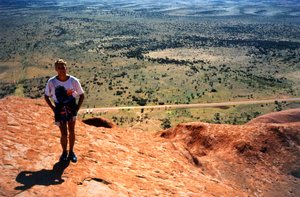Advertisement
Published: August 29th 2010

 The Top of Uluru
The Top of Uluru
Walking along the top of Uluru - or Ayers Rock as it was thenThe bus for Alice Springs left at 10.30 in the morning and would arrive some time the following morning. Just out of Darwin we entered the true Crocodile Dundee country, mile after mile after mile of bush. After several hours of it, it was starting to get severely boring, but the people on the bus were a superb laugh and there were videos to watch.
Two drivers took it in turns, with one driving whilst the other slept in a bed at the back of the bus. Unlike in England where there are signs telling you not to talk to the driver when the bus is in motion, here they positively encourage you to talk to the driver to relieve the boredom for him.
Travelling long distances on buses is an incredibly tedious and dull experience. Granted, you'll see more than you would from a plane, but in places on the scale of Australia and of North America, the same scenery can go on for hours. If you're bored however, just think how the driver feels. He's done this run a hundred times and he can't exactly read a book or grab some sleep. Unlike in Britain, where talking

 The Base of The Rock
The Base of The Rock
The base of Uluru after our climbto the driver will get you thrown into jail, some countries positively encourage you to go and talk to him. The same thing applies if you are hitching and someone offers to give you a lift. One of the reasons that they will have picked you up is for some company and for someone to talk to. He’s not going to be impressed, therefore, if you go straight to sleep.
So my Travel Tip number 4 is
"Talk to the driver on long distances". That said, we went to Australia again in 2006, and the rules on buses had changed somewhat (see
The Slow Pace of The Mature Peoples' Tour). You must now wear seatbelts, so this advice no longer applies on buses.
There were several stops on the way, mainly at roadhouses (transport cafes), but one was at some thermal springs where we could go for a swim if we wished. One of the roadhouses was at a place called Three Ways. This is where the road branches east to Townsville and south to Alice Springs. It is notorious to hitchers as you can guarantee that if you are heading south then your lift will be going east or vice-versa. Hitchers have been known

 Uluru
Uluru
The view of the rockto get stuck there for days, and sure enough there was a group of them looking extremely rough and depressed. Suckers, I've got a bus-pass la, la, la!
One strange thing about Australian busses is that if too many people close off their air-conditioning / heating nozzle, it freezes the whole system. Despite the warning from the driver, we managed to freeze the system and consequently there was no heating throughout much of the night. During the winter the temperature in the outback reaches well into minus figures so the heating was a serious loss. I remember people crying because they were so cold and, of course, we all had shorts and tee-shirts on, with all our warm clothes stashed in the hold.
We arrived in Alice Springs and who should be in the terminal but Alan and Mike, booking a bus south to Ayers Rock. I decided to travel along with them and then come back to Alice Springs later when they carried on south again. It was therefore straight onto another bus for another day of travelling.
This is the last time I will use the name Ayers Rock. First of all it is not

 Ayers Rock Gallery
Ayers Rock Gallery
Ayers Rock Aboriginal rock galleryreally a rock, but the end of a hard strata, which has been exposed after millennia of erosion - I can vaguely remember covering all this in geography at school. The Olgas (which I visited the next time I was in this area and had more time and money to see the area properly - see
So You Have Only Climbed Uluru Once Then) are formed from the other, less famous, end of the same strata.
Secondly, Ayers is the name of the first European to discover it. This assumes that something does not exist until a European discovers it. It has been of deep cultural significance to the Aborigines for thousands of years and to them it is known as Uluru, which is now also the name of the national park in which both monuments reside.
Whatever it's called, it's one hell of a climb; 2km each way with much of it requiring you to pull yourself up a chain. This was followed by a long walk along the top to reach the point that was officially the top. It was even more of an achievement for Mike as he was wearing flip-flops (or Thongs as they are rather confusingly known in Australia) at

 Distant Olgas
Distant Olgas
The Olgas from the top of Ayers Rockthe time, since his decent shoes were also out of reach in the hold of the bus.
It was surprisingly cold when you got to the top but the views were fantastic. The most shocking sight was the plaques commemorating the people who had died whilst attempting the climb, most from heart attacks or heat exhaustion. After surviving the climb in one piece, we were given a short tour around the base of the 'rock', taking in a spring and some Aboriginal rock paintings.
Advertisement
Tot: 0.065s; Tpl: 0.012s; cc: 11; qc: 24; dbt: 0.0301s; 1; m:domysql w:travelblog (10.17.0.13); sld: 1;
; mem: 1.1mb







